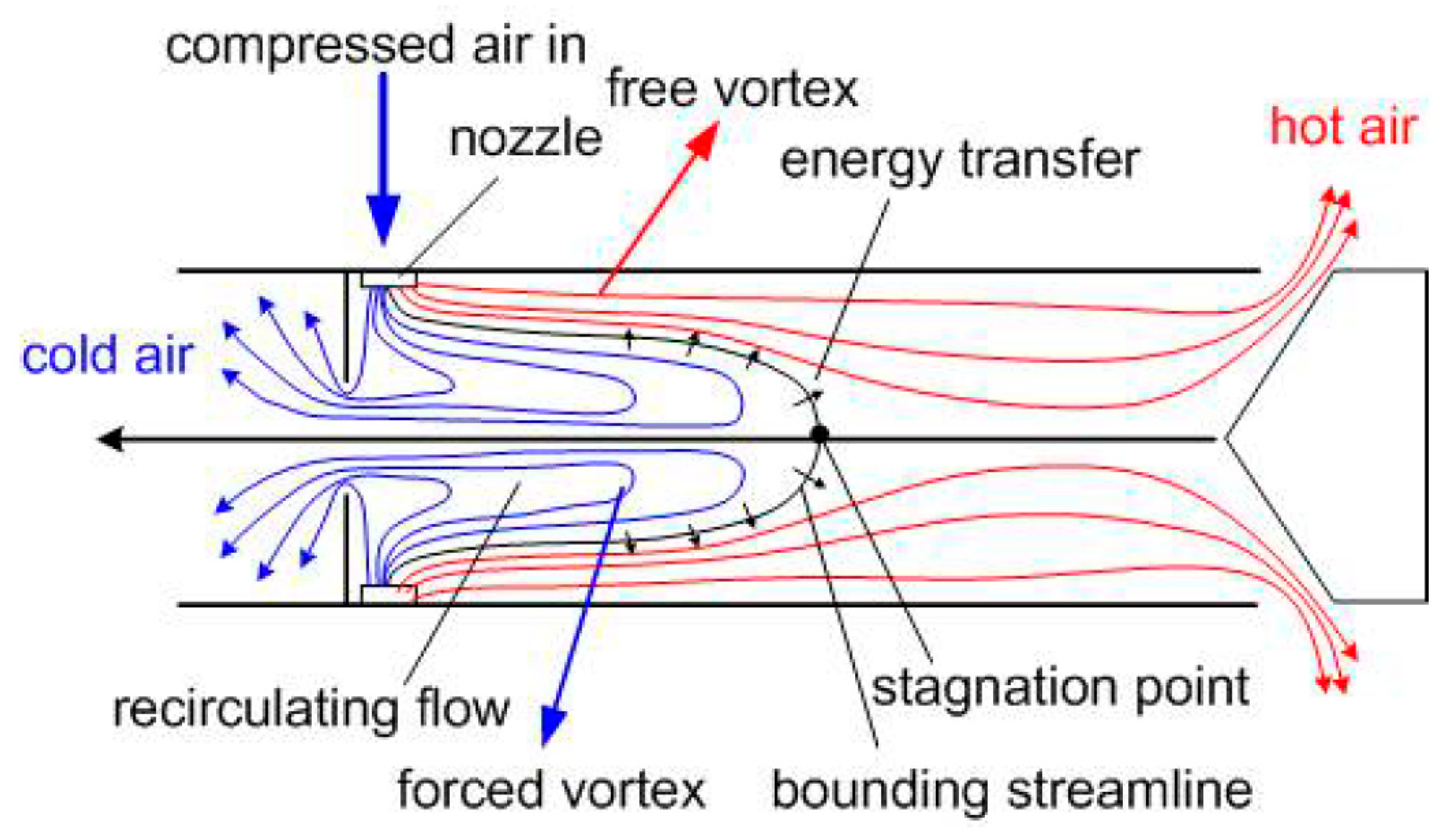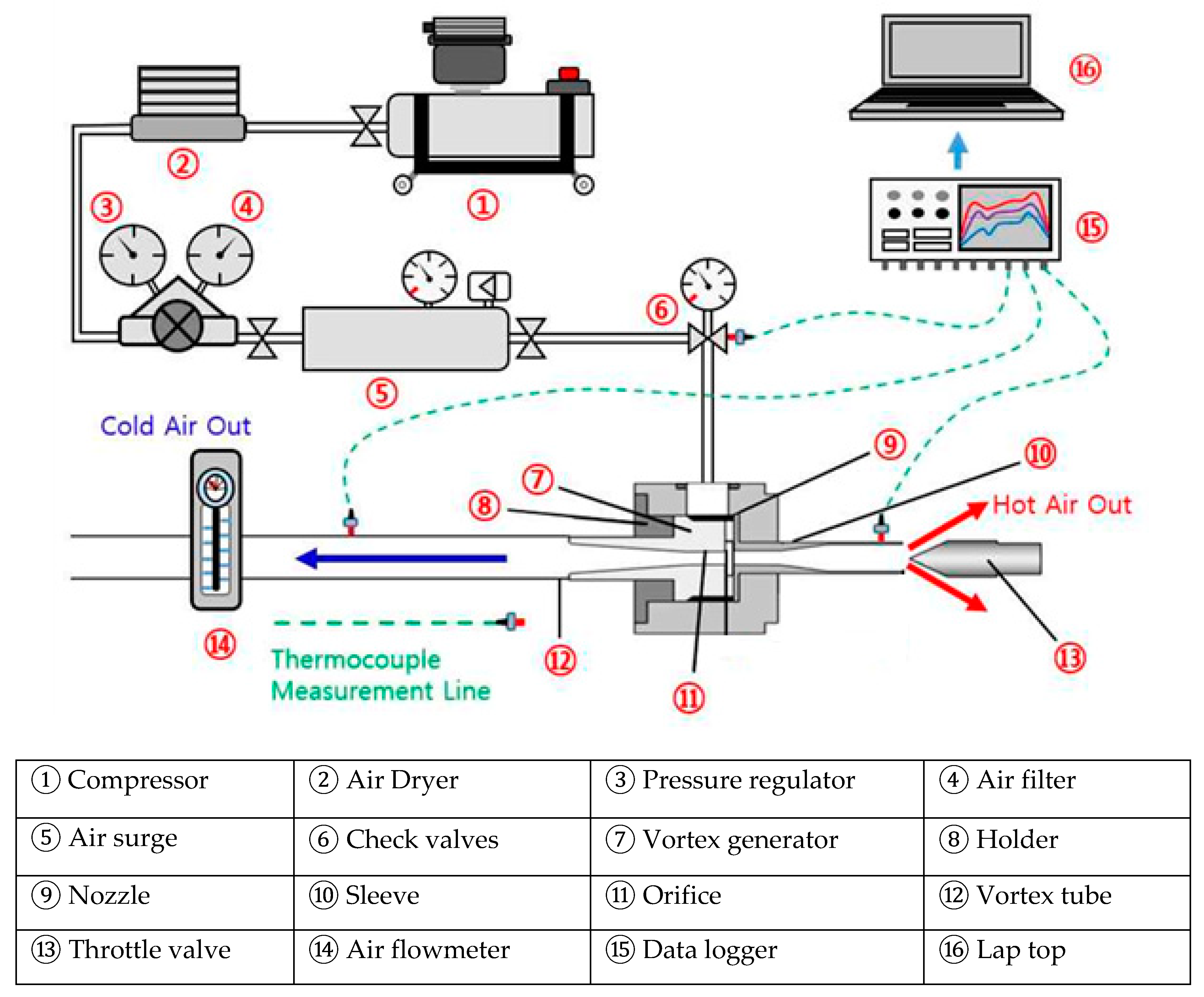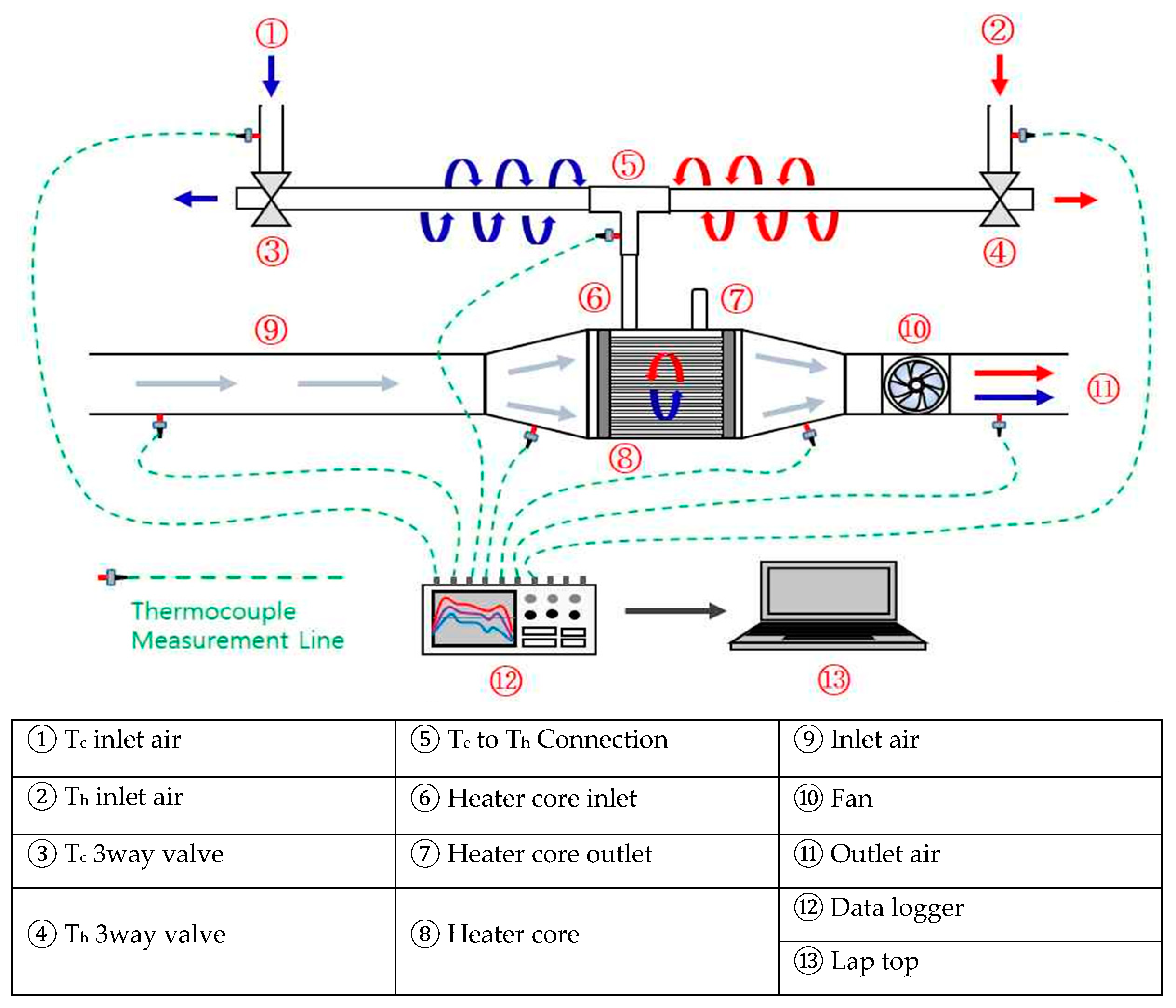A Study on the Application Possibility of the Vehicle Air Conditioning System Using Vortex Tube
Abstract
1. Introduction
2. Experimental Approach
2.1. Principle of Vortex Tube
2.2. Setup of Feasibility Study
2.3. Experimental Apparatus
3. Results and Discussion
3.1. Temperature Change According to Pressure and Generator Nozzle
3.2. Discharge Flow Rate and Temperature Difference between ΔTh, max and ΔTc, max According to Pressure
3.3. Temperature Control of Indirect Heat Exchange Method According to Pressure
3.4. Temperature Control of Direct Heat Exchange Method According to Pressure
4. Conclusions
Author Contributions
Funding
Acknowledgments
Conflicts of Interest
Nomenclature
| A | The rate of vortex flow coming inside [L/min] |
| c | Constant |
| D | The inner diameter of the vortex tube [mm] |
| dc | The diameter of cold end orifice [mm] |
| Dn | The inner diameter of nozzles [mm] |
| L | Tube length [mm] |
| Pi | The pressure of inlet air [kgf/cm2] |
| Q | Mean air flow rate [L/min] |
| Sn | Nozzle area ratio(nozzle sectional area/vortex tube sectional area [-] |
| T | Static temperature [K] |
| ∆Tac | The temperature difference between inlet air and cold outlets air for chamber [°C] (∆Tac = Taoc − Tai) |
| ∆Tah | The temperature difference between inlet air and hot outlets air for chamber [°C] (∆Tah = Taoh – Tai) |
| Taoc | The temperature of outlets cold air for chamber [°C] |
| Taoh | The temperature of outlets hot air for chamber [°C] |
| Tc | The temperature of cold air [°C] |
| ∆Tc | The temperature difference between inlet air and cold air [°C] (∆Tc = Tc – To) |
| ∆Tc, max | The maximum temperature difference between inlet air and cold air [°C] |
| Tco | The temperature of cold outlet air for after passing the fan [°C] |
| Th | The temperature of hot air [°C] |
| ∆Th | The temperature difference between inlet air and hot air [°C] (∆Th = Th – To) |
| ∆Th, max | The maximum temperature difference between inlet air and hot air [°C] |
| Tho | The temperature of hot outlet air for after passing the fan [°C] |
| Tai | The temperature of inlet air for chamber [°C] |
| ∆Tw, max | The maximum temperature difference between inlet air and hot wall [°C] |
| yc | Cold air mass flow ratio (cold air mass flow/inlet air mass flow) |
| w | Angular velocity [L/s] |
| r | Diameter radial direction |
Subscript
| c | Cold air |
| h | Hot air |
| I | Inlet air |
| max | Maximum |
| N | Nozzle and number |
References
- Jetter, J. Evaluation of Alternatives for HFC-134a Refrigerant in Motor Vehicle Air Conditioning. In Proceedings of the International Conference on Ozone Protection Technologies, Washington, DC, USA, 21–23 October 1996; pp. 845–854. [Google Scholar]
- Global Environmental Change Report, A Brief Analysis of the Kyoto Protocol. December 1997, Volume IX. No. 24. Available online: https://www.oecd.org/dev/1923191.pdf (accessed on 7 October 2020).
- Linderstrøm-Lang, C. Gas separation in the Ranque-Hilsch vortex tube. Int. J. Heat Mass Transf. 1964, 7, 1195–1206. [Google Scholar] [CrossRef]
- Ranque, G.J. Experiments on expansion in a vortex with simultaneous exhaust of hot air and cold air. Phys. Radium 1933, 112–114. [Google Scholar]
- Hilsch, R. The Use of the Expansion of Gases in a Centrifugal Field as Cooling Process. Rev. Sci. Instr. 1947, 18, 108–113. [Google Scholar] [CrossRef] [PubMed]
- Fulton, C.D. Ranque’s Tube. Refrig. Eng. 1950, 5, 473–479. [Google Scholar]
- Stephan, K.; Lin, S.; Durst, M.; Huang, F.; Seher, D. An investigation of energy separation in a vortex tube. Int. J. Heat Mass Transf. 1983, 26, 341–348. [Google Scholar] [CrossRef]
- Deissler, R.; Perlmutter, M. Analysis of the flow and energy separation in a turbulent vortex. Int. J. Heat Mass Transf. 1960, 1, 173–191. [Google Scholar] [CrossRef]
- Kassner, R.; Knoernschild, E. Friction Laws and Energy Transter in Circular Flow; Wright Patterson Air Force Base: Montgomery County, OH, USA, 1948; p. 259. [Google Scholar]
- Behera, U.; Paul, P.; Kasthurirengan, S.; Karunanithi, R.; Ram, S.; Dinesh, K.; Jacob, S. CFD analysis and experimental investigations towards optimizing the parameters of Ranque–Hilsch vortex tube. Int. J. Heat Mass Transf. 2005, 48, 1961–1973. [Google Scholar] [CrossRef]
- Gao, C.M.; Bosschaart, K.J.; Zeegers, J.C.H.; de Waele, A.T.A.M. Experimental study on a simple Ranqe-Hilsch vortex tube. Cryogenics 2005, 45, 173–183. [Google Scholar] [CrossRef]
- Westley, R. The College of Aeronautics (Cranfield) Note, No. 30(1955-5): No. 67(1957-7). Available online: https://www.cambridge.org/core/journals/aeronautical-journal/article/research-at-the-college-of-aeronautics-cranfield/E5F9971CA8C27168C0349632BF1AA963 (accessed on 7 October 2020).
- Hatnett, J.P.; Eckert, E.R.G. Experimental Study of the Velocity and Temperature Distribution in a High Velocity Vortex-type Flow. Thans. ASME 1957, 79, 751–758. [Google Scholar]
- Takahama, H. Studies on Vortex Tubes (2nd Report), Reynolds Number the Effect of the Cold Air Rate and the Partial Admission of Nozzle on the Energy Separation. Bull. JSME 1996, 9, 121–130. [Google Scholar] [CrossRef]
- Comasser, S. The Vortex tube. J. AM. Soc. Naval Eng. 1951, 63, 99–108. [Google Scholar] [CrossRef]
- Stephan, K.; Lin, S.; Durst, M.; Huang, F.; Seher, D. A similarity relation for energy separation in a vortex tube. Int. J. Heat Mass Transf. 1984, 27, 911–920. [Google Scholar] [CrossRef]
- Fröhlingsdorf, W.; Unger, H. Numerical investigations of the compressible flow and the energy separation in the Ranque–Hilsch vortex tube. Int. J. Heat Mass Transf. 1999, 42, 415–422. [Google Scholar] [CrossRef]
- Eiamsa-Ard, S.; Promvonge, P. Numerical investigation of the thermal separation in a Ranque–Hilsch vortex tube. Int. J. Heat Mass Transf. 2007, 50, 821–832. [Google Scholar] [CrossRef]
- Skye, H.M.; Nellis, G.F.; Klein, S.A. Comparison of CFD analysis to empirical vortex tube. Int. J. Refrig. 2006, 29, 71–80. [Google Scholar] [CrossRef]
- Kaya, H.; Uluer, O.; Kocaoğlu, E.; Kirmaci, V. Experimental analysis of cooling and heating performance of serial and parallel connected counter-flow Ranquee–Hilsch vortex tube systems using carbon dioxide as a working fluid. Int. J. Refrig. 2019, 106, 297–307. [Google Scholar] [CrossRef]
- Li, N.; Jiang, G.; Fu, L.; Tang, L.; Chen, G. Experimental study of the impacts of the cold mass fraction on internal parameters of a vortex tube. Int. J. Refrig. 2019, 104, 151–160. [Google Scholar] [CrossRef]
- Hu, Z.; Li, R.; Yang, X.; Yang, M.; Day, R.; Wu, H.-W. Energy separation for Ranque-Hilsch vortex tube: A short review. Therm. Sci. Eng. Prog. 2020, 19, 100559. [Google Scholar] [CrossRef]
- Rafiee, S.E.; Sadeghiazad, M.M. Experimental analysis on the impact of navigator’s angle on velocimetry and thermal capability of RH-vortex tube. Appl. Therm. Eng. 2020, 169, 114907. [Google Scholar] [CrossRef]
- Fotso, B.M.; Talawo, R.; Nguefack, M.F.; Fogue, M. Modeling and thermal analysis of a solar thermoelectric generator with vortex tube for hybrid vehicle. Case Stud. Therm. Eng. 2019, 15, 100515. [Google Scholar] [CrossRef]
- Thakare, H.; Parekh, A.D. Experimental investigation of Ranque—Hilsch vortex tube and techno—Economical evaluation of its industrial utility. Appl. Therm. Eng. 2020, 169, 114934. [Google Scholar] [CrossRef]
- Dutta, T.; Sinhamahapatra, K.; Bandyopadhyay, S.S. CFD Analysis of Energy Separation in Ranque-Hilsch Vortex Tube at Cryogenic Temperature. J. Fluids 2013, 2013, 1–14. [Google Scholar] [CrossRef]
- Im, S.Y. An Experimental Study on the Geometric setup of a Low-Pressure Vortex tube. Master’s Thesis, Chungnam National University, Daejeon, Korea, 2004. [Google Scholar]


























| Parameter | Value | Unit |
|---|---|---|
| Tube length (L) | 128 | mm |
| Inlet diameter of vortex tube (D) | 9.8 | mm |
| Inner diameter of nozzles (Dn) | 1, 1.2, 1.4, 1.7, 2.1 | mm |
| Diameter of cold end orifice (dc) | 6 | mm |
| Number of nozzle holes (Nh) | 4, 5, 6, 7, 8 | - |
| Nozzle area ratio (Sn) | 0.142 | - |
| Instrument | Model | Range | Uncertainly |
|---|---|---|---|
| Graphtec | GL 840 Midi Logger | - | ±0.5% |
| Thermo-couple | K-type | −100 to 650 °C | ±2.5 °C |
| Pressure sensor | Dream31 (A-type) Dream | −1 to 6 bar | ±1.5% |
| Gas regulator | Renown | 0–6 bar | ±2.0% |
| Air compressor | Renown | 20 HP | - |
| Air surge tank | Renown | 280 L | - |
| Pi | Th, max | yc | Nh | Tc, max | yc | Nh |
|---|---|---|---|---|---|---|
| 0.5 | 8.86 °C | 0.6 | 5 hole | −5.57 °C | 0.5 | 7 hole |
| 1.0 | 15.06 °C | 0.8 | 7 hole | −14.17 °C | 0.5 | 6 hole |
| 1.5 | 24.51 °C | 0.8 | 6 hole | −15.90 °C | 0.5 | 7 hole |
| 2.0 | 30.42 °C | 0.8 | 4 hole | −20.08 °C | 0.5 | 7 hole |
| 2.5 | 37.17 °C | 0.8 | 7 hole | −24.06 °C | 0.5 | 7 hole |
| 3.0 | 45.55 °C | 0.8 | 7 hole | −26.90 °C | 0.5 | 7 hole |
| 3.5 | 47.61 °C | 0.8 | 7 hole | −29.66 °C | 0.5 | 7 hole |
| 4.0 | 53.38 °C | 0.8 | 7 hole | −32.05 °C | 0.5 | 7 hole |
| 4.5 | 57.70 °C | 0.8 | 7 hole | −34.46 °C | 0.5 | 7 hole |
| 5.0 | 60.51 °C | 0.8 | 7 hole | −36.33 °C | 0.5 | 7 hole |
© 2020 by the authors. Licensee MDPI, Basel, Switzerland. This article is an open access article distributed under the terms and conditions of the Creative Commons Attribution (CC BY) license (http://creativecommons.org/licenses/by/4.0/).
Share and Cite
Kim, Y.; Im, S.; Han, J. A Study on the Application Possibility of the Vehicle Air Conditioning System Using Vortex Tube. Energies 2020, 13, 5227. https://doi.org/10.3390/en13195227
Kim Y, Im S, Han J. A Study on the Application Possibility of the Vehicle Air Conditioning System Using Vortex Tube. Energies. 2020; 13(19):5227. https://doi.org/10.3390/en13195227
Chicago/Turabian StyleKim, Younghyeon, Seokyeon Im, and Jaeyoung Han. 2020. "A Study on the Application Possibility of the Vehicle Air Conditioning System Using Vortex Tube" Energies 13, no. 19: 5227. https://doi.org/10.3390/en13195227
APA StyleKim, Y., Im, S., & Han, J. (2020). A Study on the Application Possibility of the Vehicle Air Conditioning System Using Vortex Tube. Energies, 13(19), 5227. https://doi.org/10.3390/en13195227





